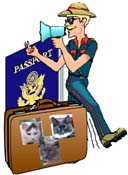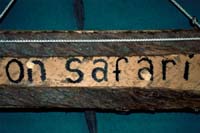
Jan's Travel-Rama
Point Arena, CA

Jan's Travel-Rama
Point Arena, CA
 This was the sign we used on our tent "door" at Kichwa Tembo. |
Hi there - |
||
|
After several wonderful days in the
Serengeti National Park, we flew back to Arusha. From there, we were driven to
Nairobi, Kenya to prepare for our 3 day safari extension at Kichwa Tembo Tented
Camp. The border crossing at Namanga (from Tanzania to Kenya) was quite an
experience. Unfortunately because the border installation is a government
facility, we couldn't take any photos. But the experience could have been right
out of a Hemingway novel or out of an Indiana Jones movie. There were cattle,
chickens, donkeys and other livestock walking throughout the compound. There
were cars, carts, sleeping bags, knapsacks and all other sorts of conveyances
and luggage. No ten people spoke the same language. |
|||
If you want to comment on our Website, please feel free to contact Wookie at 3kitty.org.
| Home | Three Kitty Photo |
Jan's Travel-Rama | Yoda's Tales | Three Kitty Konstruction |
|---|---|---|---|---|
| Three Kitty Kreations | Three Kitty Kommunity | Three Kitty Kompany | Three Kitty Kuisine | Jan's Personal Note |
Website v2.1 design by Three Kitty Komputing, Point Arena,
CA 